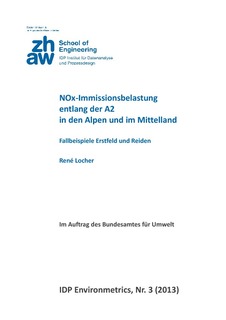Please use this identifier to cite or link to this item:
https://doi.org/10.21256/zhaw-126| Publication type: | Working paper – expertise – study |
| Title: | NOx-Immissionsbelastung entlang der A2 in den Alpen und im Mittelland : Fallbeispiele Erstfeld und Reiden |
| Authors: | Locher, René |
| DOI: | 10.21256/zhaw-126 |
| Extent: | 34 |
| Issue Date: | 2013 |
| Series: | IDP Environmetrics |
| Series volume: | 3 |
| Publisher / Ed. Institution: | ZHAW Zürcher Hochschule für Angewandte Wissenschaften |
| Publisher / Ed. Institution: | Winterthur |
| ISBN: | 978-3-905745-70-2 |
| Language: | German |
| Subjects: | Luftqualität; Räumlich-zeitliche Verteilung; Gam; Robuste Regression; Air quality; Gam; Robust regression; Temporal spatial distribution |
| Subject (DDC): | 363: Environmental and security problems |
| Abstract: | The report discusses temporal and spatial distribution of ambient concentration of NO2 in a valley in the alps, which is strongly affected by the transalpine traffic. Based on meteorological and air quality measurements and on regional emission inventary, the proportion of ambient concentration due to road transport was quantified. The study area was situated in Erstfeld in the lower Urner Reusstal. Between 2007 and 2009, the traffic on the A2 motorway caused about 40% of the pollution load of NO2 – thereof the cargo transport alone about 25%. During the study period, the construction of the New Rail Link through the Alps (NRLA) also contributed considerably to NO2 concentration. Without the contributions from this construction work, the total traffic on the A2 to the NO2 concentrations accounts for about 55% and the proportion of cargo transport for about 35 %. Another 20% of NO2 concentration accrue from local traffic and about 25 % from stationary sources. With the exhaust emission and engine technology being continously improved, the contribution of traffic is supposed to further decrease. Im Fokus der Arbeit steht die räumlich-zeitliche Verteilung der NO2-Immissionsbelastung in einem Alpental, das stark durch den alpenquerenden Verkehr betroffen ist. Dabei wird insbesondere der Anteil des Strassengüterverkehrs an der Luftschadstoffbelastung quantifiziert. Anhand von Angaben zu den regionalen Emissionen und meteorologischer Bedingungen im Untersuchungsgebiet wurden die einzelnen Quellanteile für das Fallbeispiel Erstfeld (Kanton Uri) abgeschätzt. Im Zeitraum 2007 bis 2009 war der Gesamtverkehr der Autobahn A2 in Erstfeld für rund 40% der Immissionsbelastung verantwortlich – der Güterverkehr alleine verursachte ca. 25% der gesamten Immissionsbelastung. Während der Untersuchungsperiode trugen die Arbeiten an der Neuen Alpentransversale (NEAT) ebenfalls erheblich zur NO2-Belastung bei. Diese Bauarbeiten sind nun fertig gestellt – entsprechend nimmt der Anteil des Verkehrs an den gesamten NO2-Immissionen zu. Der Beitrag des Gesamtverkehrs auf der A2 an den NO2-Immissionen beträgt, nach Herausrechnen des NEAT-Anteils, rund 55%, wobei der Anteil des schweren Güterverkehrs alleine auf rund 35% zu liegen kommt. Neben dem Beitrag der Autobahn stammen nach Abschluss der NEAT-Bauarbeiten ca. 20% der NO2-Immissionsbelastung vom lokalen Verkehr und rund 25% von stationären Quellen. Mit der fortschreitenden Abgas- und Motorentechnologie ist in Zukunft mit einer starken Abnahme des Verkehrsanteils an der NO2-Immissionsbelastung zu rechnen. The report discusses temporal and spatial distribution of ambient concentration of NO2 in a valley in the alps, which is strongly affected by the transalpine traffic. Based on meteorological and air quality measurements and on regional emission inventary, the proportion of ambient concentration due to road transport was quantified. The study area was situated in Erstfeld in the lower Urner Reusstal. Between 2007 and 2009, the traffic on the A2 motorway caused about 40% of the pollution load of NO2 – thereof the cargo transport alone about 25%. During the study period, the construction of the New Rail Link through the Alps (NRLA) also contributed considerably to NO2 concentration. Without the contributions from this construction work, the total traffic on the A2 to the NO2 concentrations accounts for about 55% and the proportion of cargo transport for about 35 %. Another 20% of NO2 concentration accrue from local traffic and about 25 % from stationary sources. With the exhaust emission and engine technology being continously improved, the contribution of traffic is supposed to further decrease. |
| URI: | https://digitalcollection.zhaw.ch/handle/11475/126 |
| Fulltext version: | Published version |
| License (according to publishing contract): | Licence according to publishing contract |
| Departement: | School of Engineering |
| Organisational Unit: | Institute of Data Analysis and Process Design (IDP) |
| Appears in collections: | IDP Environmetrics |
Files in This Item:
| File | Description | Size | Format | |
|---|---|---|---|---|
| 604011800.pdf | 2.86 MB | Adobe PDF |  View/Open |
Show full item record
Locher, R. (2013). NOx-Immissionsbelastung entlang der A2 in den Alpen und im Mittelland : Fallbeispiele Erstfeld und Reiden. ZHAW Zürcher Hochschule für Angewandte Wissenschaften. https://doi.org/10.21256/zhaw-126
Locher, R. (2013) NOx-Immissionsbelastung entlang der A2 in den Alpen und im Mittelland : Fallbeispiele Erstfeld und Reiden. Winterthur: ZHAW Zürcher Hochschule für Angewandte Wissenschaften. Available at: https://doi.org/10.21256/zhaw-126.
R. Locher, “NOx-Immissionsbelastung entlang der A2 in den Alpen und im Mittelland : Fallbeispiele Erstfeld und Reiden,” ZHAW Zürcher Hochschule für Angewandte Wissenschaften, Winterthur, 2013. doi: 10.21256/zhaw-126.
LOCHER, René, 2013. NOx-Immissionsbelastung entlang der A2 in den Alpen und im Mittelland : Fallbeispiele Erstfeld und Reiden. Winterthur: ZHAW Zürcher Hochschule für Angewandte Wissenschaften
Locher, René. 2013. “NOx-Immissionsbelastung entlang der A2 in den Alpen und im Mittelland : Fallbeispiele Erstfeld und Reiden.” Winterthur: ZHAW Zürcher Hochschule für Angewandte Wissenschaften. https://doi.org/10.21256/zhaw-126.
Locher, René. NOx-Immissionsbelastung entlang der A2 in den Alpen und im Mittelland : Fallbeispiele Erstfeld und Reiden. ZHAW Zürcher Hochschule für Angewandte Wissenschaften, 2013, https://doi.org/10.21256/zhaw-126.
Items in DSpace are protected by copyright, with all rights reserved, unless otherwise indicated.